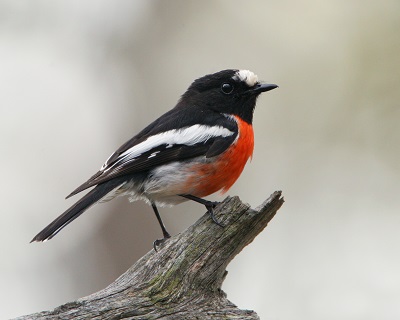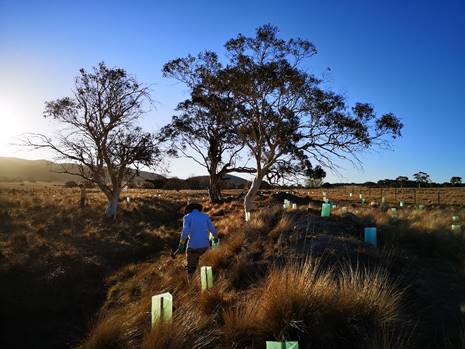Bush for birds - everyone can help!
October 2020
Andy Taylor, Senior Natural Resource Management Advisor
This is Part 3 in a series of articles aimed at raising awareness of the plight of our small woodland birds, many of which have become threatened with extinction.
“Extinction sounds overwhelming but there are lots of things we can do to help these amazing and precious birds to survive and flourish on farms and in regional areas of south eastern NSW.”
Damon Oliver, Threatened Species Manager, NSW Department of Planning, Industry and Environment.


What we know is that protecting and better managing the habitat of these birds is crucial to their survival. While these birds have declined in recent decades and are at risk of extinction in the future, we know that their survival is entirely within our reach if we choose to act now.
So where to start?
Looking after existing patches of native bush by controlling grazing pressure, retaining fallen timber and leaf litter and putting back shrubs and groundcover layers is the most important action we can take. Allowing the bush to become a bit ‘messy’ helps to provide a range of niches for nesting, foraging and moving about between patches. It also keeps the larger, menacing birds like ravens (crows), currawongs and noisy miners at bay as they prefer the neater and more open areas.
Looking after your very old paddock trees is another important conservation measure you can make on your farm. They not only provide food and nest hollows for birds, mammals and other animals, but they also provide important shade and shelter for stock, help soil health and they look beautiful. Re-establishing native trees and shrubs across paddocks is another crucial step as this helps to reconnect patches of bush, which then allow birds to move about and disperse across the landscape. Dispersal of young birds, after they fledge from the nest, seeking out their own patch is an important way to increase the size of their populations. For land managers who are interested in integrating revegetation for conservation of birds and farm production benefits the Save Our Scarlet Robin Project team can help you with ideas that help the birds and your farm operations.
Consider the following questions to help you manage your property for bird life
How much area do I need?
The golden rule for conservation of birds and all native plants and animals is “the bigger the better” but a minimum patch or corridor of 2ha has been shown to support small bird habitat. Viable patches can be smaller if there are larger patches of remnant vegetation nearby. Corridors or windbreaks should be a minimum of 30m wide, but wider will always help deter undesirable birds like noisy miners that exclude the smaller birds we are trying to help. All plantings should aim for a minimum of 60% shrubs and maximum of 40% trees. Shrubs are so important as protective nesting and foraging sites for small birds but can also provide benefits to soil health and occasional stock fodder depending on the species.
If your property is small, you can consider creating stepping-stone plantings (min 400m2) that will help small birds move between larger patches of habitat. Stepping-stones should be located no more than 100m from another patch of vegetation as small birds are more vulnerable to predation and the larger aggressive birds will exclude them when they move over large distances without cover. It also takes a lot more energy to fly long distances to safety.
I have lots of remnant trees but no wattles or shrubs. What should I do?
Easy! Wattles and shrubs are the real powerhouse of small bird habitat. You can infill plant with wattles and shrubs and the structural diversity you provide will help support a range of small birds. Contact Landcare or your nearest Local Land Services office for a suitable species list to avoid putting the wrong plant species into an established vegetation community. And remember the 60:40 rule of thumb, shrubs to trees!
My existing planting sites are mostly eucalypts, should I do anything?
If they are planted closely together (closer than 5m apart) don’t be afraid to thin them out as they can eventually become stunted as they compete for resources (seek advice from Local Land Services before undertaking thinning). Use minimum 40% shrubs rule to work out how many need to go and how many replacements of wattle and shrubs you need. If the eucalypts are well-spaced, start to incorporate wattles and other native shrubs in the gaps. If the existing site is a funded planting contact the funding organisation for advice.
Are there benefits to production in my grazing enterprise?
Farm production and biodiversity conservation are not necessarily mutually exclusive. There’s a large body of research that supports the fact that land managers can actually make productivity gains through increasing biodiversity on-farm. The benefits of incorporating biodiversity into agriculture range from enhancing stock and soil health, stock shelter, biological pest control, nutrient cycling, erosion management, greater resilience against weed invasion, reduced fertiliser use, greater retention and infiltration of water into the soil, and the slowing down of runoff across paddocks.
Fallen timber - Firewood vs Biodiversity
Many of us still use wood burning heaters, and often collect firewood from our own properties. If doing so, remember that leaving parts of your property a bit ‘messy’, and leaving dead standing and fallen timber is very important in supporting local biodiversity. As discussed above, this biodiversity can provide enormous benefits to your property and livestock. Consider planting a firewood patch of fast-growing black wattle. It will support bird life whilst it grows, provides hot burning wood and can replenish itself given the right management.
I’m worried about erosion in the areas I want to protect
Fencing areas and revegetating can put a stop to most erosion on your property. Include the right mix of native plant species to support our woodland birds. Local Land Services can help with advice to ensure you get the most out of both your erosion control and your revegetation efforts.
Keep an eye out for our next article on helping threatened woodland birds to bounce back!
If you have more questions or would like to learn more about the Save Our Scarlet Robin project or want to tell us about the birds you see on your property please contact Andy Taylor at andy.taylor@lls.nsw.gov.au or (02) 4842 2594.